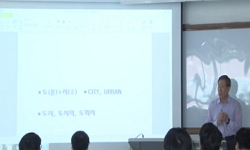The Korean Constitution stipulates the landtothetillers principle and tenant farming prohibition in clause 1 of article 121. Also, in clause 2, the exceptional cases of leasing and consignment management of agricultural land for incr...
http://chineseinput.net/에서 pinyin(병음)방식으로 중국어를 변환할 수 있습니다.
변환된 중국어를 복사하여 사용하시면 됩니다.
- 中文 을 입력하시려면 zhongwen을 입력하시고 space를누르시면됩니다.
- 北京 을 입력하시려면 beijing을 입력하시고 space를 누르시면 됩니다.

경자유전의 원칙과 소작제도금지의 헌법적 함의 = The Constitutional Meaning of the Landtothetillers Principle and TenantFarming Prohibition
한글로보기https://www.riss.kr/link?id=A76486658
- 저자
- 발행기관
- 학술지명
- 권호사항
-
발행연도
2007
-
작성언어
-
- 주제어
-
KDC
360
-
등재정보
KCI등재
-
자료형태
학술저널
- 발행기관 URL
-
수록면
103-121(19쪽)
-
KCI 피인용횟수
11
- 제공처
-
0
상세조회 -
0
다운로드
부가정보
다국어 초록 (Multilingual Abstract)
The Korean Constitution stipulates the landtothetillers principle and tenant farming prohibition in clause 1 of article 121. Also, in clause 2, the exceptional cases of leasing and consignment management of agricultural land for increasing agricultural productivity and rationally utilizing agricultural land or due to unavoidable circumstances are recognized under the conditions as prescribed by the law. Accordingly, legislators must carry out legislative right of formation regarding agricultural land under the principles of article 121 of the Constitution. Agricultural land is, in a larger sense, a kind of land, but the Korean Constitution separates the former from land in general in that the Constitution has already placed certain constitutional restrictions on agricultural land. Because the Constitution has a unique system of regulation regarding agricultural land, there is a need to systematically interpret the stipulations on property rights in article 23 and the stipulations in article 121.<BR> Although the landtotillers principle or tenant farming prohibition is meaningful in that it works to stop the distortion of agricultural production structure under the economic structure of an agrarian society, it needs to be examined in new ways because of its relevance on various basic rights of today’s agricultural land. In the legal systems of foreign countries, their systems are composed in such way that their legislations enable principles such as landtothetillers principle to be maintained, even if it is not explicated in their Constitution. This is so because agricultural land is not only the site of agricultural production but also controls the chaotic urbanization on the outskirts of large cities, and agricultural land preservation plan is intimately connected to the protection of people’s environmental rights.<BR> There are legitimate reasons for the issues of agricultural land policy to be treated separately from those dealing with general land. Although in a larger sense it is a restriction of basic rights, it also opens the possibility of choosing a wide range of beneficial management approaches for those who work in the agricultural industry. Legislators need to recognize that agricultural land policy is intimately connected to such things as the reorganization of the world’s economic order, the FTA contract, the guarantee of a minimum production level regarding food, and the issues of environmental preservation through the securement of areas of arable land that are shrinking, and they need to consider each of the factors appropriately.
목차 (Table of Contents)
- Abstract
Ⅰ. 머리말
Ⅱ. 헌법에 나타난 경자유전의 원칙
Ⅲ. 농지와 일반 토지의 차별적 규율
Ⅳ. 헌법 제121조 제1항의 규정에 대한 해석 방법
Ⅴ. 경제질서 및 기본권과 경자유전의 원칙
Ⅵ. 맺음말
참고문헌
- Abstract
Ⅰ. 머리말
Ⅱ. 헌법에 나타난 경자유전의 원칙
Ⅲ. 농지와 일반 토지의 차별적 규율
Ⅳ. 헌법 제121조 제1항의 규정에 대한 해석 방법
Ⅴ. 경제질서 및 기본권과 경자유전의 원칙
Ⅵ. 맺음말
참고문헌
동일학술지(권/호) 다른 논문
-
- 한국토지공법학회
- 성소미(Seong So-Mi)
- 2007
- KCI등재
-
- 한국토지공법학회
- 김재호(Kim Jae-Ho)
- 2007
- KCI등재
-
- 한국토지공법학회
- 박종국(Park Jong-Guk)
- 2007
- KCI등재
-
- 한국토지공법학회
- 이헌석(Lee Heon-Seog)
- 2007
- KCI등재
분석정보
인용정보 인용지수 설명보기
학술지 이력
| 연월일 | 이력구분 | 이력상세 | 등재구분 |
|---|---|---|---|
| 2027 | 평가예정 | 재인증평가 신청대상 (재인증) | |
| 2021-01-01 | 평가 | 등재학술지 유지 (재인증) |  |
| 2018-01-01 | 평가 | 등재학술지 유지 (등재유지) |  |
| 2015-01-01 | 평가 | 등재학술지 유지 (등재유지) |  |
| 2011-01-01 | 평가 | 등재학술지 유지 (등재유지) |  |
| 2009-01-01 | 평가 | 등재학술지 유지 (등재유지) |  |
| 2007-01-01 | 평가 | 등재학술지 유지 (등재유지) |  |
| 2004-01-01 | 평가 | 등재학술지 선정 (등재후보2차) |  |
| 2003-01-01 | 평가 | 등재후보 1차 PASS (등재후보1차) |  |
| 2002-01-01 | 평가 | 등재후보학술지 유지 (등재후보1차) |  |
| 1999-07-01 | 평가 | 등재후보학술지 선정 (신규평가) |  |
학술지 인용정보
| 기준연도 | WOS-KCI 통합IF(2년) | KCIF(2년) | KCIF(3년) |
|---|---|---|---|
| 2016 | 0.84 | 0.84 | 0.73 |
| KCIF(4년) | KCIF(5년) | 중심성지수(3년) | 즉시성지수 |
| 0.69 | 0.69 | 0.687 | 0.35 |





 스콜라
스콜라


